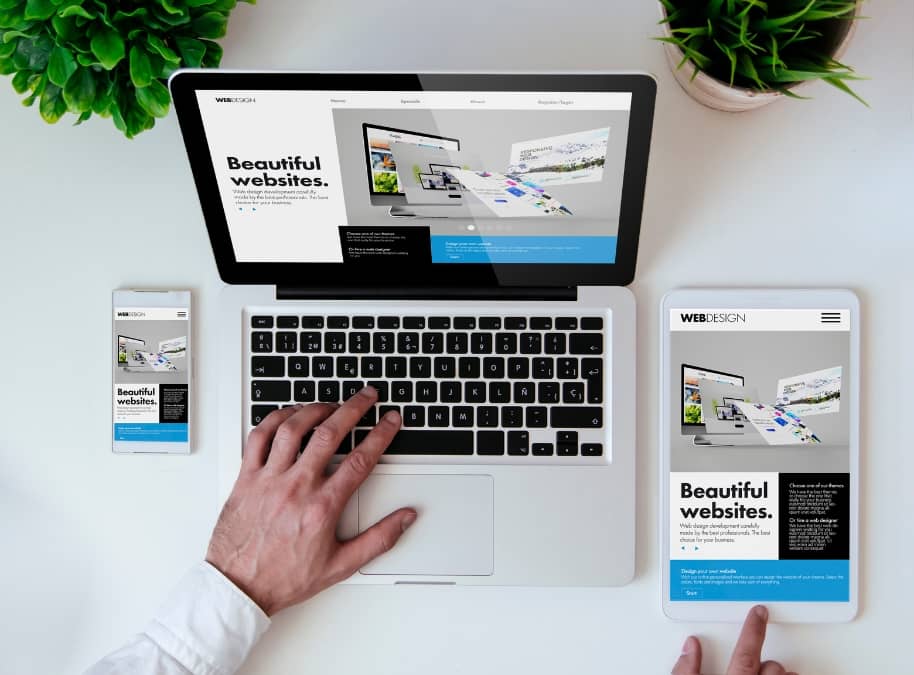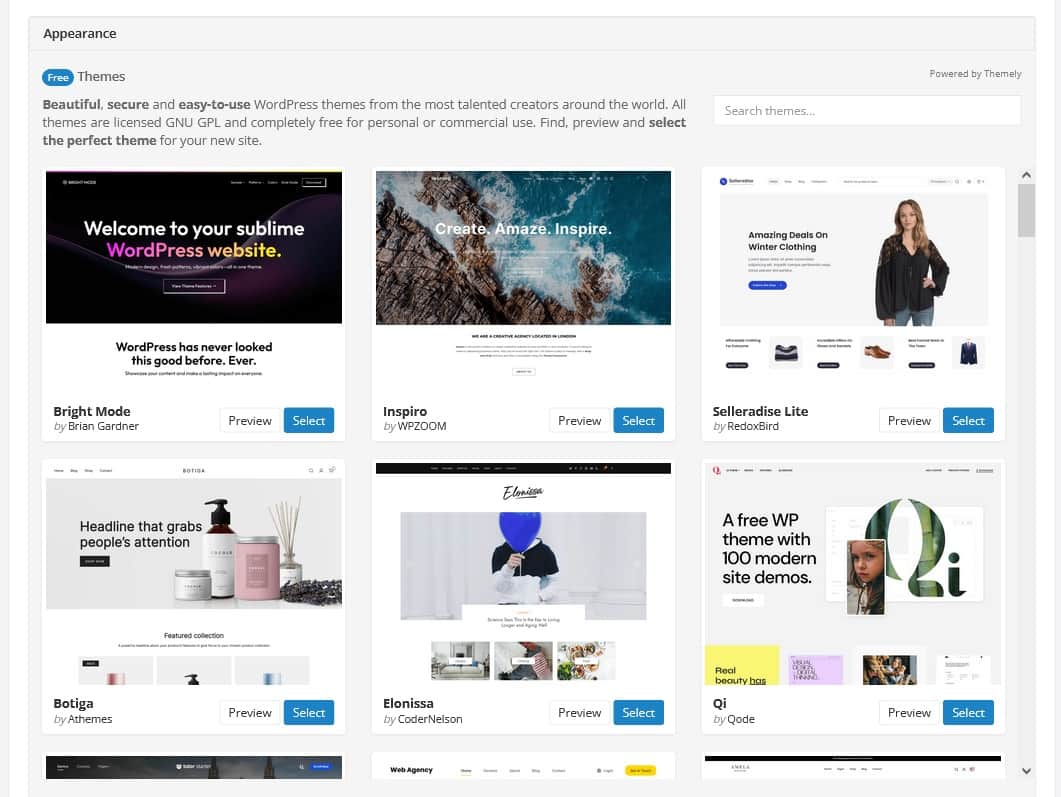Choosing to build your website with WordPress can be an exciting venture. The possibilities are endless, and your vision is ready to come to life. But after going through the steps to install WordPress, next comes the first big decision you have to make—picking a theme.
With over 12,000 themes in the WordPress repository and thousands more from third-party websites, it's easy to feel lost in the sea of options.
With almost half of all websites built with this CMS, many people have been where you are. The good news is choosing a WordPress theme becomes much simpler when you know what to look for.
In this post, I'll guide you on how to choose a WordPress theme like a pro. First, we'll go over why making the right choice is crucial. Then, we'll explore ten key factors to consider and ensure your chosen theme provides the best user experience possible for your site visitors and you.
So, without further ado, let's dive in.
Why Choosing the Right WordPress Theme Is Crucial
You probably already know that the theme you choose for your WordPress site will determine how it looks to visitors. As such, one mistake most inexperienced site owners make is to go for the most visually appealing theme.
But does having a stunning website guarantee success? Granted, it may help make a memorable and good first impression on your site visitors. However, choosing a suitable theme for your WordPress site goes beyond aesthetics.
It's also about how easy visitors find it to interact with and navigate your site. Besides user experience, the theme you pick will influence the ease with which you can perform administrative tasks or customize and manage your website.
A well-chosen theme will ensure your website is fast, secure, and easy to use. On the other hand, a poorly chosen theme can lead to a host of issues. It might make your website slow, difficult to navigate, and ultimately drive away visitors.
Not only does your theme dictate the look and feel of your site, but also how it functions. It affects SEO and how well content appears across different devices.
With so much riding on this decision, it's crucial to choose wisely. So, what exactly should you look for in a WordPress theme to ensure the best performance? Find out below.
How to Choose a WordPress Theme: Top 10 Features to Consider
Now that you understand the importance of choosing the best theme for your WordPress site, we'll dive into the top 10 features you should consider to ensure your site performs at its best.
1 Design and Layout

The first thing you want to consider is the design and layout of a theme.
Choosing a WordPress theme that comes with starter templates can greatly simplify the setup process. Such themes typically include ready-made templates for the homepage, blog, contact, about us, and other essential web pages, making it easier to get your site up and running quickly.
Ensure that the general layout aligns with the website structure you envision. The best way to achieve that is to focus on the purpose your website will serve. Are you creating a portfolio, online store, news site, or something else entirely?
Once you clarify your website's purpose, go for themes created with your specific industry in mind. Depending on what that is, you could narrow your search to photography website themes, or small business WordPress themes, or corporate WordPress themes, for instance. And you can use the same approach by searching for starter templates for your specific niche.
Themes created for specific industries often come with layouts suited to meet the demands of those niches. That should simplify finding a theme or starter template that fits your needs and requires less customization.
As you explore the design of various WordPress themes, remember that a user-friendly layout is paramount. It should guide visitors effortlessly, making it easy to find what they want as they navigate the site.
Furthermore, opting for simplicity can benefit your site immensely. Although intricate animations and elaborate designs might catch the eye, a straightforward and clean theme often performs better. It will enhance usability while ensuring your content stands out and captures visitor's attention without distractions.
💡 Pro Tip: Take some time to browse websites in your industry to get a feel for different trending design options. If you stumble across WordPress sites that you particularly like, identify the theme they're using. This step might offer inspiration or a potential starting point for your website's design.
2 Features and Functionalities
Are you running an international website that caters to people who speak different languages? Then, you may need a WordPress theme that has built-in translation features. Do you want to offer courses or gated content? That calls for a theme that supports user registration and integrates with your chosen payment system.
Aligning your theme choice with your audience's needs will significantly enhance the user experience.
Here are a few more examples of must-have features suited for common types of websites:
Of course, you can always enhance functionality with plug-ins. However, a theme that integrates most of your required features will serve you better. This approach ensures smoother integration and reduces the complexity of managing multiple add-ons for basic functionalities.
💡 Pro Tip: To simplify your search for free WordPress themes, use the feature filter in the WordPress theme repository. This tool allows you to specify the features you need, making it easy to find a theme that fits your design, layout, and functional requirements.

3 Customization
Another crucial aspect to consider is customization. Most likely, you won't find a theme that matches your website needs right out of the box. As such, having the ability to make some tweaks here and there is essential.
The theme you select will no doubt dictate the look and feel of your website. But that's not necessarily cast in stone.
Using the built-in WordPress theme customizer, you can make some simple changes to the active theme on your site. That includes options like customizing the fonts (typography), headers, footers, color schemes, and layouts.
Keep in mind, though, that WordPress themes are not created equal. Some will be more customizable than others. Those offering shortcodes and the option to add custom CSS and widgets will add functionality and enhance the user experience without needing additional plug-ins.
The more customization options you have, the easier it will be to align your website with your brand aesthetics. Therefore, consider WordPress themes that integrate with popular page builders.
Why? Well, that's because page builders make it possible to customize WordPress themes even further. Their drag-and-drop interfaces are easy to use and provide more tools with a high degree of flexibility. So you'll be able to create unique layouts and designs for a more professional look.
With that in mind, look for themes that indicate compatibility with page builders like WPBakery, Elementor, Thimify, Beaver, or Divi. Some themes offer a customizer demo. If they do, test them to see what page elements are customizable.
Remember, the more customizable your theme is, the greater flexibility you will have to create a website that truly reflects your brand.
4 Responsive Design

Did you also know that over half of website traffic comes from mobile and handheld devices? Therefore, choosing a responsive WordPress theme is vital now more than ever.
A responsive theme will automatically adjust its layout to fit various screen sizes. That way, every single user will have an excellent experience. And in the process, this will significantly improve user engagement and retention.
Additionally, responsiveness is a user experience metric that Google rewards with higher rankings. Hence, there is even more reason to ensure a seamless user experience on desktops, tablets, and smartphones.
That said, it's not just enough to choose a theme labeled as "responsive" or "mobile-friendly" in the description. Go one step further and ensure it's up to scratch by testing its demo on different devices.
Most theme developers provide a live preview link that you can use to test responsiveness. Take advantage of that.
For a more thorough check, you can use a tool like MobileMoxie to evaluate how well a theme performs across different devices on Chrome.
Reading user reviews can also provide insights into how well a theme performs across different devices.
5 Compatibility
After ensuring responsiveness, the next step in understanding how to choose a WordPress theme is to check if it is compatible with the plug-ins and tools you or your site visitors plan to use.
Ensure your chosen theme works seamlessly with page builders and essential plug-ins you expect to use for SEO, security, social sharing, e-commerce, contact forms, etc. This integration is vital for enhancing your website's functionality and performance.
Additionally, make sure the theme is compatible with different browsers. A theme that looks great on Chrome but not on Microsoft Edge, Firefox, or Safari can alienate a significant portion of your audience.
To verify compatibility, read the theme's documentation. Check for any listed compatible plug-ins and tools.
User reviews and support forums can also provide great insights. Look out for any compatibility issues others have faced and shared.
Ensuring compatibility from the start will save you time and prevent headaches later. Think of it this way: It's just one more box to check to ensure a smooth experience for you and your visitors.
Launch Your WordPress Site with Ease
Get reliable web hosting with DTS-NET and install WordPress in just a few clicks using Softaculous. Focus on choosing the perfect theme—we’ll handle the setup so you can get online faster.
Get Web Hosting6 SEO-Friendly
The next crucial factor in your quest to figure out how to choose a WordPress theme is SEO friendliness.
Remember, the theme you pick will build the pages that search bots will crawl through to index your site. So, it has to be optimized to ensure your content is easily discoverable by search engines.
An SEO-friendly WordPress theme will adhere to several critical aspects. Firstly, it will have clean and efficient code. Well-structured code contributes to fast load times.
Secondly, find out in theme descriptions or documentation if there is any mention of support for schema markup. Themes that support this can help search engines understand your website content better. That, in turn, can lead to your pages appearing for more relevant search queries, which translates to improved click-through rates and higher traffic.
Thirdly, if you plan to use SEO plug-ins, check whether they are compatible with your chosen WordPress theme.
To assess a WordPress theme's SEO friendliness, you can enter the live preview URL of those themes into tools like Google's Page Speed Insights or GTmetrix. They'll assess page-loading times and core web vitals performance, helping you to determine if the theme supports a fast, efficient, and SEO-friendly site.

By ensuring these elements are in place, you'll pave the way for selecting a WordPress theme that boasts an attractive design while enhancing your website's ability to achieve higher rankings in search results.
7 Updates
Besides SEO friendliness, you want to ensure that your chosen theme gets regular updates. Every theme will have a "last updated" attribute. It can be a good indicator of how committed the developers are to keeping it up-to-date.
Regular theme updates will benefit your website in several ways. For instance, they will ensure it remains compatible with the latest version of WordPress and other essential plug-ins.
A frequently updated theme also benefits from enhanced security patches and bug fixes. That will reduce the risk of vulnerabilities, which could compromise your website.
Moreover, updates often include new features and improvements. So, they'll keep your site modern and functional, helping it adapt to future changes and challenges.
8 Support

Equally important is the availability of support. Having access to a reliable support team can be invaluable. It can be a lifesaver, especially when you have customization questions or encounter issues.
Keep in mind, though, that WordPress themes that are free to use don't typically offer the same kind of dedicated support as those that charge a premium fee. So, if something happens, you'll be on your own.
That's why the theme you choose should, at the very least, offer detailed support resources (e.g., forums, video tutorials, set-up and troubleshooting guides, or a knowledge base).
9 Budget
With updates and support covered, let's shift our focus to budget considerations. WordPress themes come in both free and paid versions.
While free WordPress themes can be appealing, they often come with limitations. For instance, they might lack certain features, customization options, or regular updates and support. As such, this can result in additional future costs if, at some point, you need to hire a developer to make modifications or troubleshoot issues.
On the other hand, premium WordPress themes usually offer features that are more robust, better customization options, and reliable support.
Investing in a premium theme can save you time and money in the long run. And most of the time, these themes are typically well-maintained and frequently updated. However, note that premium themes may attract one-time or annual license fees.
Ultimately, it's essential to evaluate what you truly need. If you're starting a simple blog, a free theme might suffice. But for more complex sites, like e-commerce stores or portfolios, a premium theme could provide the advanced features and stability you require.
Consider your budget carefully and balance it against your needs. Doing so will help you choose the WordPress theme that offers the best value for your specific project.
10 Reviews & Ratings

Reading reviews can help you understand common issues other users have encountered. It's also an opportunity to assess how responsive the theme developers are in addressing those issues.
Look for patterns in the feedback. Are users consistently praising the theme's ease of use? Or are there recurring complaints about bugs and poor support?
Ratings can give you a quick snapshot of a theme's overall quality. Higher ratings generally indicate a well-received and reliable theme. However, dig deeper into the reviews to fully understand the theme's strengths and weaknesses. Resolvable issues that come up don't necessarily have to be a deal breaker.
In addition to the official WordPress theme directory, check forums and review sites for more detailed insights on user experiences.
With this comprehensive approach, you can avoid pitfalls and select a reliable WordPress theme.
Over to You
Each highlighted element plays a vital role in ensuring that your website looks great and, at the same time, performs efficiently and effectively. With this approach, you can narrow your search to the best options.
Remember, your WordPress theme is the foundation of your online presence. With the ideal theme, you'll have a solid foundation to build a fast, secure, and user-friendly website.
Armed with tips on how to choose a WordPress theme, it's time to start exploring and experimenting. Dive into the WordPress theme repository, test out different demos, and find the perfect fit for your unique needs. Happy theme hunting!
Launch Your WordPress Site with Ease
Get reliable web hosting with DTS-NET and install WordPress in just a few clicks using Softaculous. Focus on choosing the perfect theme—we’ll handle the setup so you can get online faster.
Get Web HostingFAQs on How to Choose a WordPress Theme
A WordPress theme is a collection of stylesheets and code that determine the visual appearance and functionality of any website that runs on WordPress. It allows users to change the look and feel of their site without altering the core WordPress software code.
Simply put, a WordPress theme is the overall design framework of your site. It controls the colors, typography, and general appearance across all pages.
On the other hand, a WordPress template is a specific page layout within a theme. For example, your theme might include templates for the homepage, blog posts, or contact page.
In short: themes define the site’s overall look, while templates define how individual pages are structured.
You can buy WordPress themes from various marketplaces and developers. Popular sources include the official WordPress theme repository, third-party marketplaces like ThemeForest, Themify, StudioPress, ThemeGrill (to name a few), and directly from theme developers' websites.
To identify the WordPress theme a website is using, you can use tools like WPThemeDetector or view the site's source code (right-click on the page, then select 'View Page Source'). Press ctrl/cmd + F and search for the 'wp-content/themes' directory in the code to find the theme name.
WordPress themes can be customized using several methods. You can use the built-in WordPress customizer for simple changes like colors, fonts, and layouts. For more advanced customization, consider using page builders like Elementor or WPBakery, which offer drag-and-drop interfaces and extensive customization options.


